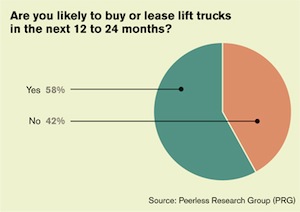Reader Survey: Lift trucks are back
Modern readers tell us how they’re buying, using and maintaining their fleet
Coaches like to say that you can’t win at sports without a focus on the fundamentals. It’s the reason that athletes who have played a sport as far back as grade school still take batting practice, hit the blocking sled and practice their free throws lest those fundamentals get away from them.
When it comes to materials handling, there is nothing more fundamental than the lift truck. You can run a warehouse without a conveyor and sortation system, an automated storage and retrieval system (AS/RS) or even bar code scanning. But just try to keep running without a lift truck. It’s the reason that for all the glitz and glamour associated with automation, lift truck booths still garner big crowds at trade shows, like the roll out of new cars at the auto show.
Webcast: How does your fleet management program measure up?
How then are end users acquiring, using and maintaining their lift truck fleets? Those are questions Peerless Research Group (PRG) asked Modern readers in our annual lift truck usage survey. (See what readers said in last year’s survey.) Here’s what they had to say.
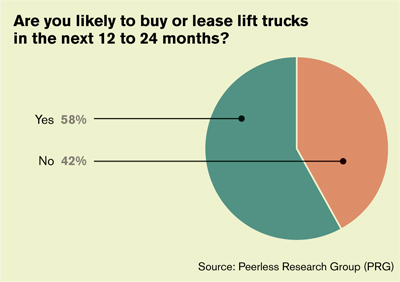
Electric trucks predominate
Modern readers operate a significant number of lift trucks: As many are using 50 or more trucks (13.7%) as are using fewer than three trucks (14%). The average respondent operates 21 in their facility.
They are also using the full gamut of lift trucks types, and a majority of facilities is using more than one type. As with last year’s survey, electric trucks are far more common than internal combustion (IC) powered trucks, continuing a trend that has been in place for the last several years.
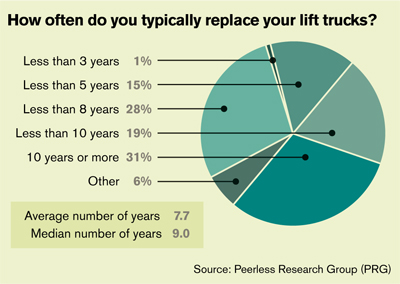
Buying plans
Modern readers make the most of their lift truck acquisitions, replacing their lift trucks every seven years. There is also evidence that the replenishment cycle that was put on hold during the economic downturn is back in swing: Nearly 58% of those surveyed plan to buy or lease a lift truck within the next 12 to 24 months. That’s down by 10% from the 64% who planned to buy or lease trucks in last year’s survey, but still a majority of respondents.
On average, they plan to acquire five new trucks, and nearly as many respondents said they were making new additions to their fleets as said they were replacing trucks currently in use.
While the lift truck industry is offering more financial packages and options than in the past, buying is still more common than leasing. Nearly 60% said they purchase lift trucks outright while 22% said they buy some and lease some. Only 19% said they only lease.
Those who buy do so because they believe it is cheaper (37%), for accounting reasons (34%) or because buying delivers a better ROI (29%).
Those who lease appreciate the ability to outsource maintenance as part of a lease agreement (56%), reduce their upfront investment and adjust their fleet size (52%) and remain current on technology (31%).
The remaining respondents buy slightly more trucks (52%) than they lease (48%). Most say it is a situational decision. For instance, some manufacturers maintain a core number of lift trucks and lease others on a short-term basis to handle seasonal peaks.
While the economic downturn in 2008 had a profound impact on the lift truck industry, 60% said the economy has little or no impact on how they acquire lift trucks today. Only 21% said it influenced their decision to a great extent. This reinforces the importance of a lift truck to keeping a facility operational—regardless of the economy, any plant or DC still in operation has to maintain a fleet of lift trucks to keep running.
Brand loyalty
In other surveys, Modern readers indicate a fair amount of loyalty to suppliers of equipment that is bolted to the floor or integrated into the system, like conveyors or software. In both cases, replacing a vendor can result in a long, costly and painful implementation period.
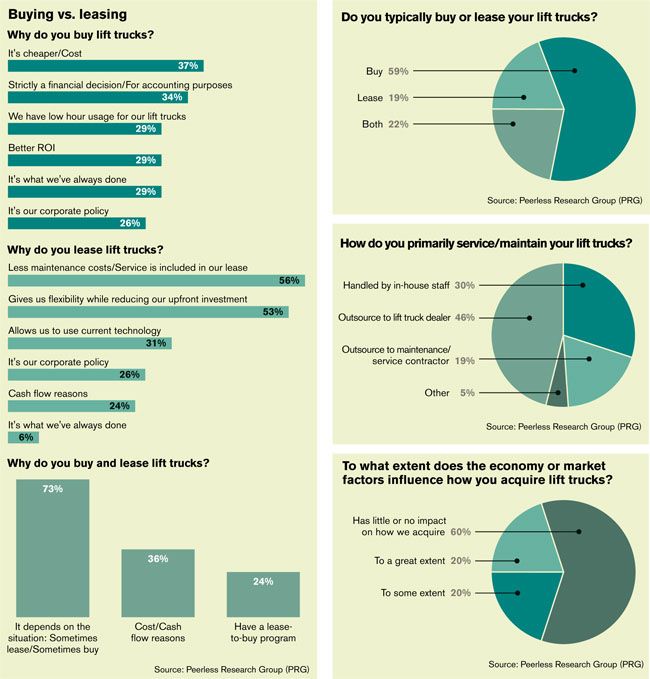
Lift trucks appear to fall into the plug and play category, with less brand loyalty. Only 16% of respondents said they were not very or not all likely to evaluate a new supplier when adding lift trucks to their fleet. Only 36% said they went into an evaluation period with an approved vendor list.
At the same time, the field appears to be wide open for the vendor community: Only 18% of respondents said they had a cause to remove a vendor from their short list in the last two years, primarily as a result of poor service. That should be a wake up call to lift truck dealers and manufacturers alike to keep service and customer relations top of mind.
Maintaining and managing a fleet
When making a purchase, the vast majority (83%) of respondents purchase their trucks from a dealer rather than directly from the manufacturer. Service is a contributing factor, since only 30% of respondents maintain their lift trucks with their in-house staff. Another 46% outsource maintenance to the lift truck dealer, while 19% outsource to a maintenance and service contractor.
Not surprisingly, the parts most likely to be purchased in the next 12 months are life-limited parts, like wheels and tires (65%), batteries (60%) and tune-up parts (50%); or consumables, such as chemicals, lubricants and oil (51%) and hoses, filters and valves (32%).
Controlling costs, or some variation of that statement, was the most common reason given for turning over maintenance to an outside organization.
“Outsourcing maintenance allows us to focus on our business,” wrote one respondent.
“They are the cheapest and their on-site turnaround of a repair is more rapid than we can do in-house,” wrote another.
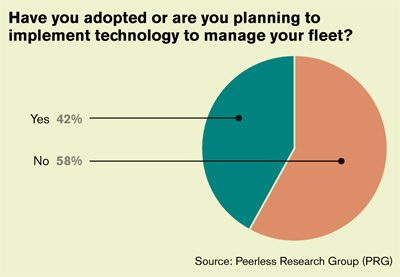
The role of technology
Modern readers remain slow to embrace fleet management technologies and software systems. In this year’s survey, 42% of respondents said they had adopted or are planning to adopt fleet management technology, tracking the 43% who indicated the same in last year’s survey.
Of those early adopters, maintenance history (78%) and maintenance costs (73%) are the metrics most likely to be tracked, followed by data related to safety (65%), such as accidents and injuries, the age of the fleet (58%) and fleet utilization levels (54%).
A significant majority of respondents said that the implementation of fleet management software had been somewhat (46%), very (41%) or extremely (7%) successful. Only 6% said that the implementations had not been successful.
While anecdotal, the most common challenges to the implementation and use of fleet management software are external rather than whether the technology itself works. Respondents noted that they had issues related to getting associates to input data; convincing older lift truck operators to use the system; making sure floor and maintenance personnel provide accurate data; or that they couldn’t convince management to invest in a system.
Those who had no plans to implement fleet management technologies said that they are able to get fleet management data from their lift truck dealer; that their fleets were too small to benefit from the technology; or, that they weren’t even aware of the availability of the technology.
The adoption rate, and the respondent comments, could indicate that the industry has already targeted the large users most likely to benefit from fleet management software. Or it could be a signal that there is still a significant portion of the market that has yet to hear about the technology.
Operator training is a must
The performance of the lift truck operator is as essential as the performance of the truck to a safe and productive operation.
Properly trained drivers also reduce the wear and tear on their trucks and lead to less damage to product and the building. That may explain all but three respondents indicated that they rely on some type of training for their lift truck operator. Many are relying on more than one type of program.
Most respondents (82%) rely on an internal training program for their driver. Meanwhile, 15% work with dealers and 14% work with independent service providers.


